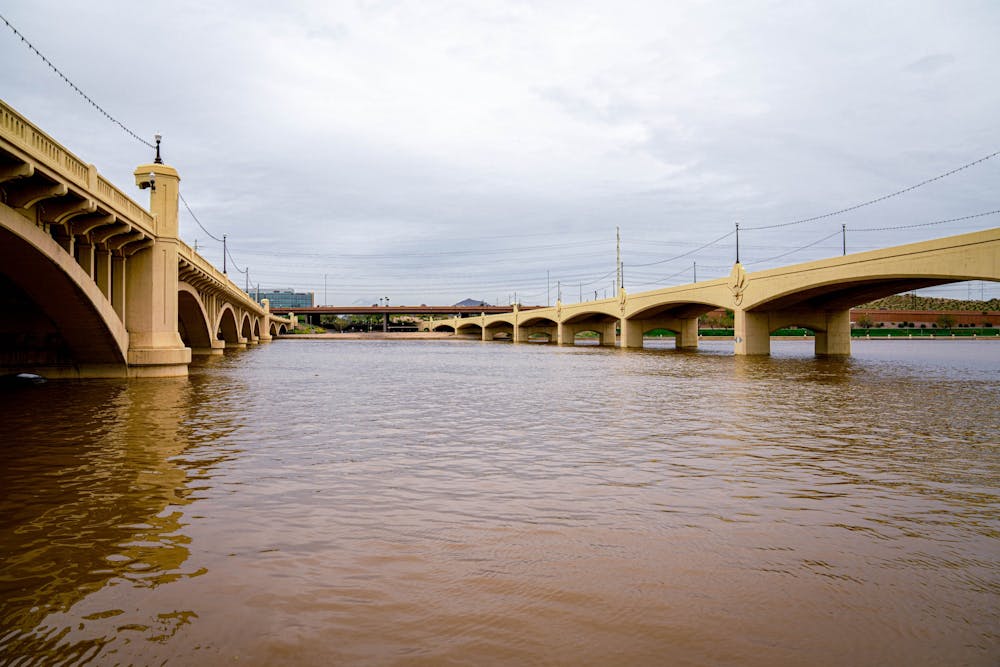Tempe Town Lake's water levels have sharply increased because of high levels of precipitation and upstream release from Granite Reef Dam northeast of Phoenix.
All month, the National Weather Service has issued flood warnings and advisories across Arizona. An NWS flood warning on Wednesday warns of flooding of unbridged crossings across Tempe Town Lake.
Tempe Town Lake is a reservoir located on the Salt River in north Tempe used for flood protection, recreation opportunities and economic vitality according to the city of Tempe. The lake is filled with water from the Salt River and Colorado River and captures water from storm drains and rainwater runoff.
Recently, water levels have increased significantly because of winter weather in higher elevations in the state. Overall, this winter has been particularly wet, with October 2022 through January 2023 being the 24th wettest time period in the last 128 years.
"Because of this week’s warm storms, the snow on the watershed is continuing to melt and make its way into the Verde reservoirs, which are already 83 percent full," Salt River Project spokesperson Patty Garcia-Likens said in a press release Tuesday. "During wet years like this, inflows frequently exceed the reservoir storage capacity on the Salt and Verde rivers necessitating releases into the Salt River bed."
According to SRP's daily water report on Wednesday, Salt River reservoirs were an average of 97% full, which is 25% more than the water level this time last year.
Austin Heffernan, a sophomore studying architectural studies and a member of the Rowing Club at ASU, said he and the rest of the crew have noticed the increased levels and it’s impacted their ability to be on the water.
"The water is not just really, really high but all the trash, branches and wood are making big weed piles and ripped the skeg off the boat," Heffernan said. Skegs are a fin that helps direct a boat.
In order to prevent reservoirs from flooding and damaging dams, it is common for water to be released back into the flowing Salt River and the city of Tempe said it is prepared for the increased flow.
The Tempe Town Lake is regulated by Town Lake Dam which releases water back into the Salt River when levels get too high.
"Due to a higher than usual snowpack this winter, Salt River Project is releasing water from several dams in the region," said city of Tempe spokesperson Maegan Pardue in an email. "At this time, the city expects minimal impact to the lake and surrounding areas and does not anticipate changes in operation regarding Tempe Town Lake."
According to Kelin Whipple, a professor at the School of Earth and Space Exploration, the extra water in the Salt River and Tempe Town Lake isn’t a reason to worry but a reason to celebrate.
"The main thing we're looking at is the nice comfortable fact that our reservoirs have gotten full, and that there's extra water soaking in the ground," Whipple said. "We're recharging some of our groundwater. These are all really good things for our water outlook in the decade ahead."
Whipple said scientists predicted drier winters because of human-caused climate change, but despite the recent abnormally high rates of rain and snow, Arizona’s over 20-year megadrought is far from over.
Climate change causes unpredictability and a speedier hydrological cycle that "gets ramped up like you put it on steroids," Whipple said.
READ MORE: Opinion: Arizona's water crisis needs more political attention
"This one winter is just one little white winter," Whipple said. "We spend a lot of time in class trying to get students to be aware of what climate change is doing, where we can expect things to go with Arizona and emphasizing how precarious our water supply really is."
Annually around 2.7 million people visit Tempe Town Lake, but with recent conditions, the lake looks less familiar with water running under bridges that usually cross dry land. In addition to the increased flow, Heffernan said the lake has been dirtier than usual.
"It looks pretty disgusting," Heffernan said.
While water levels and debris continue to rise due to climate change, Whipple said he remains hopeful. Whipple said humans have faced challenges in the past and they will be able to do it again.
"When things get really serious, we are good at that," Whipple said. "As long as we can see the problem coming in advance, know what it is and enough of the population is aware of it, we have the capacity to make significant changes."
Edited by Shane Brennan, Jasmine Kabiri, Piper Hansen and Caera Learmonth.
Reach the reporter at alysa.horton@gmail.com and follow @alysa_horton on Twitter.
Like The State Press on Facebook and follow @statepress on Twitter.
Alysa is a senior studying journalism and mass communication with a minor in political science. This is her fifth semester with The State Press. She has also worked at The Arizona Republic.




